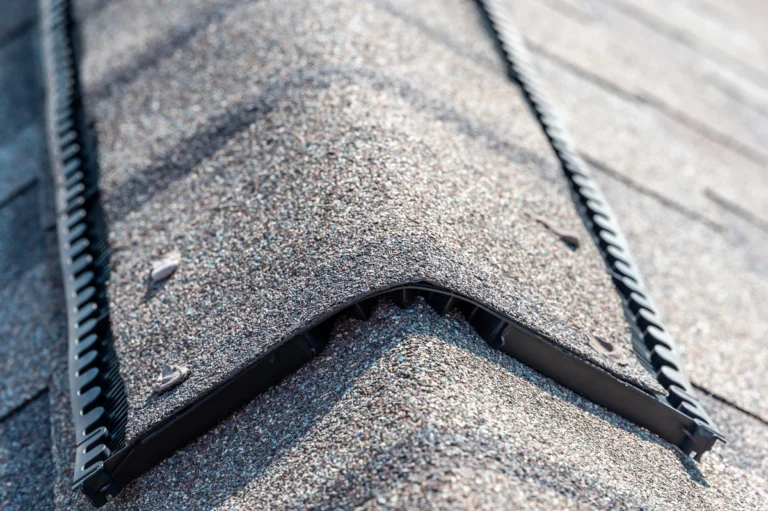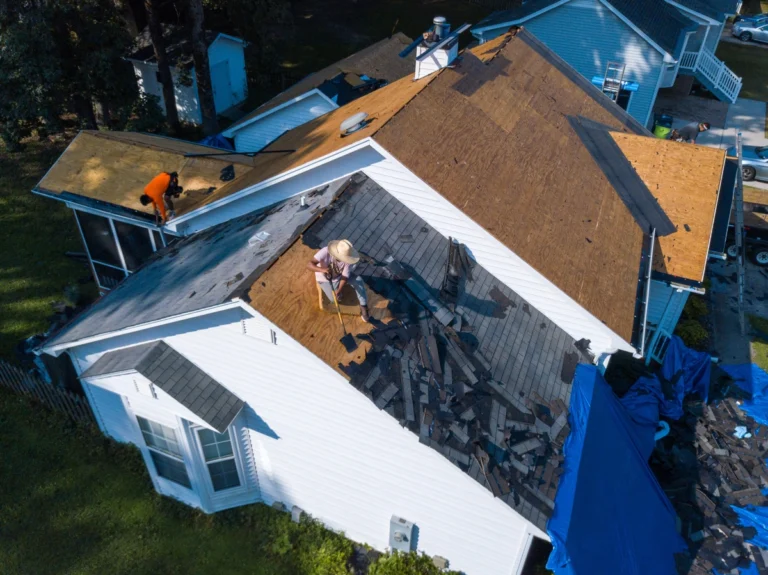Your home’s roof is your first line of defense against the elements, and one of the most significant threats it faces is wind damage. Whether you live in a region prone to hurricanes, tornadoes, or simply experience occasional strong gusts, understanding the potential impact of wind on your roof is crucial.
In this comprehensive guide, we will explore:
- Wind speeds that cause damage
- Signs of wind damage
- Shat to do when dealing with wind damage
- The cost of roof repairs
- How to find a quality contractor to get your roof back in top shape
Wind Speeds That Cause Damage

The level of wind damage your roof can endure depends on various factors, including your location, the design of your roof, and the materials used in its construction. However, here are some general wind speed guidelines to keep in mind:
Low Wind Speeds (up to 45 mph):
- Roofs are typically designed to withstand these wind speeds without significant damage.
- Minor cosmetic issues like loose shingles or gutter damage may occur but are easily fixable.
Moderate Wind Speeds (45-60 mph):
- Shingles may start to lift and curl at the edges.
- Potential for missing shingles or damaged flashing.
- Gutter and downspout damage may become more pronounced.
High Wind Speeds (60-90 mph):
- Increased risk of shingle damage, especially if they are older or improperly installed.
- Roof sheathing or decking can be exposed, leading to potential leaks.
- Flashing around chimneys, vents, and skylights may be compromised.
Severe Wind Speeds (over 90 mph):
- Severe structural damage is possible, including roof sections being torn off.
- Water penetration becomes a significant concern, leading to interior damage.
- The risk of complete roof failure or collapse increases significantly.
Signs of Wind Damage
Detecting wind damage to your roof promptly can save you from more extensive and costly repairs down the line. Here are some common signs to look out for:
- Missing or Loose Shingles: High winds can rip shingles off your roof, leaving gaps that expose your home to water damage.
- Curling or Lifting Shingles: Shingles that curl at the edges or lift up indicate potential damage and may need replacement.
- Granule Loss: Check your gutters and downspouts for an excessive buildup of shingle granules, which can indicate wear and tear due to wind damage.
- Dented or Damaged Flashing: Look for bent or damaged flashing around chimneys, vents, and skylights, as this can lead to leaks.
- Water Stains on Ceilings or Walls: Interior water stains often indicate roof damage that has allowed moisture to penetrate.
- Sagging Roof: A sagging or drooping roofline can be a sign of severe structural damage and should be addressed immediately.
What to Do When Dealing with Wind Damage to Your Roof
When you suspect wind damage to your roof, taking prompt action is crucial to prevent further issues. Here’s a step-by-step guide on what to do:
1) Safety First:
Ensure your safety and the safety of others by staying away from damaged areas. If you suspect structural damage, evacuate your home and contact a professional.
2) Document the Damage:
Take photos and notes of the damage for insurance purposes. Keep records of any temporary repairs or expenses related to the damage.
3) Contact Your Insurance Company:
File a claim with your homeowners’ insurance company as soon as possible. Provide them with the documentation you collected.
4) Temporary Repairs:
Cover exposed areas with tarps to prevent further water intrusion. Temporary repairs should be done by professionals if possible.
5) Hire a Qualified Roofing Contractor:
Seek recommendations from friends, family, or neighbors for reputable contractors. Verify the contractor’s credentials, licenses, and insurance coverage. Get multiple quotes for the repair work.
6) Communicate with Your Contractor:
Discuss the extent of the damage and the proposed repairs. Ensure you understand the timeline, costs, and materials used for the repair.
7) Monitor the Repair Process:
Stay informed about the progress of the repair work. Inspect the finished job to ensure it meets your expectations.
The Cost to Repair Your Roof

The cost of repairing wind damage to your roof can vary widely based on several factors, including the extent of the damage, the roofing materials used, and your location. Here are some general cost considerations:
- Minor Repairs: Small, localized wind damage may cost anywhere from $100 to $500 to repair.
- 4.2 Shingle Replacement: Replacing missing or damaged shingles can range from $1 to $4 per square foot.
- Roof Decking and Underlayment: If structural damage is involved, costs can increase significantly, often ranging from $1,000 to $3,000 or more.
- Flashing and Vent Repairs: Repairing or replacing flashing and vents typically costs between $200 and $600 each.
- Full Roof Replacement: In severe cases, a full roof replacement may be necessary, costing anywhere from $5,000 to $15,000 or more, depending on the size and materials.
It’s essential to obtain multiple quotes from reputable contractors and discuss the scope of work to get an accurate estimate for your specific situation. Remember that insurance may cover a portion of the repair costs, depending on your policy and the cause of the damage.
How to Find a Quality Contractor
Finding the right roofing contractor is crucial to ensure that your wind-damaged roof is repaired properly and at a fair price. Follow these steps to find a quality contractor:
Ask for Recommendations: Seek referrals from friends, family, or neighbors who have recently had roof repairs or replacements.
Check Online Reviews: Look for reviews on websites like Yelp, Angie’s List, or the Better Business Bureau to gauge a contractor’s reputation.
Verify Credentials: Ensure the contractor is licensed and insured to work in your area. Check for any complaints or legal issues against the contractor.
Request References: Ask the contractor for references from previous customers. Contact these references to inquire about their experience with the contractor.
Get Multiple Quotes: Obtain quotes from at least three different contractors. Compare the scope of work, materials, and pricing provided in each quote.
Ask Questions: Interview potential contractors about their experience, warranties, and the timeline for your project. Ensure they can handle the specific type of roof and damage you have.
Review the Contract: Read and understand the contract thoroughly before signing. Ensure it includes all details, such as materials, labor, payment terms, and timelines.
Stop Roof Wind Damage In Its Tracks!
Dealing with wind damage to your roof can be a stressful experience, but with the right information and approach, you can navigate the process effectively. Remember that the severity of wind damage can vary, and taking prompt action to assess and repair any issues is crucial. Always prioritize safety, consult your insurance company, and choose a reputable contractor to ensure your roof is restored to its protective best, safeguarding your home from the elements for years to come.
If you’re ready to repair roof damage from strong winds, Sundance Kitchen, Baths, & Exteriors can help! Contact us today to get started!





